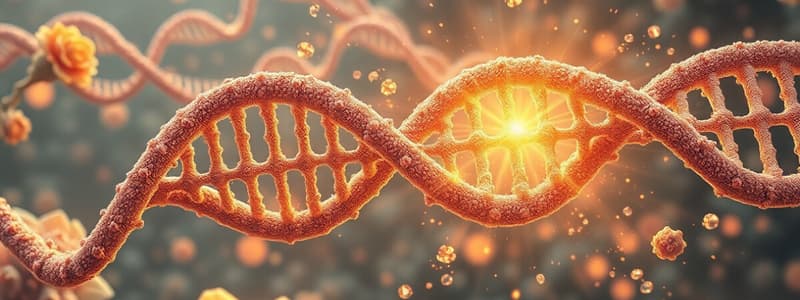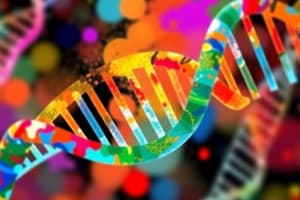Podcast
Questions and Answers
What is the total number of items indicated in the content?
What is the total number of items indicated in the content?
- 36
- 37 (correct)
- 38
- 39
Which of the following numbers does not appear in the content?
Which of the following numbers does not appear in the content?
- 20
- 25
- 7
- 40 (correct)
What is the highest numbered item mentioned in the content?
What is the highest numbered item mentioned in the content?
- 38
- 37 (correct)
- 36
- 35
How many numbers in the content are less than 10?
How many numbers in the content are less than 10?
Which option correctly identifies a pattern in the numbers presented?
Which option correctly identifies a pattern in the numbers presented?
Flashcards
Programming Language
Programming Language
A computer program that helps create other programs.
Syntax
Syntax
A specific set of rules that define the structure and meaning of a programming language.
Function
Function
A block of code that performs a specific task.
Variable
Variable
Signup and view all the flashcards
Debugging
Debugging
Signup and view all the flashcards
Study Notes
DNA Translation
- DNA translation is the process of decoding genetic information in mRNA to synthesize proteins
- It occurs on ribosomes within the cytoplasm
- Involves multiple steps: initiation, elongation, and termination
Key Components of Translation
- mRNA (Messenger Ribonucleic Acid):
- Single-stranded RNA molecule
- Carries genetic instructions from DNA to the ribosome
- tRNA (Transfer Ribonucleic Acid):
- Small RNA molecule
- Helps decode mRNA into proteins
- Ribosomes:
- Molecular machines made of rRNA and proteins
- Site of protein synthesis
Amino Acids
- Building blocks of proteins
What is DNA Translation?
- DNA translation is the process of decoding genetic information in mRNA to produce proteins.
- This process happens on ribosomes inside the cell.
- It involves many steps, including initiation, elongation, and termination.
DNA Translation Processes
- Initiation:
- The small ribosomal subunit attaches to the mRNA at the 5' end
- The initiator tRNA carrying methionine binds to the start codon (AUG)
- The large ribosomal subunit joins, forming the complete ribosome
- Elongation:
- A new tRNA binds to the codon at the A site
- A peptide bond forms between amino acids in the P and A sites
- The ribosome translocates, shifting tRNA to the E and P sites
- The process repeats to elongate the polypeptide chain
- Termination:
- A stop codon (UAA, UAG, or UGA) enters the A site
- Release factors bind to the ribosome
- The polypeptide chain detaches
- The ribosome disassembles, releasing mRNA and tRNA
DNA Applications
- Agriculture: DNA plays a role in modifying crops.
- Medicine and Healthcare: DNA is used to diagnose diseases and develop treatments.
- Industrial Applications: DNA has industrial applications.
What is DNA?
- DNA, or deoxyribonucleic acid, is a molecule containing the hereditary instructions for building and maintaining an organism.
- It's a type of nucleic acid, a long chain of nucleotides.
Where is DNA Located?
- DNA is located inside the cell nucleus, which is the control center of the cell.
- Within the nucleus are chromosomes, thread-like structures composed of DNA coiled around proteins called histones.
Gene vs DNA
- A gene is a segment of DNA
- Genes code for molecules with specific functions.
- Genes transmit for the inheritance of phenotypic traits.
- DNA is a double helix molecule containing the genetic instructions of all known living organisms.
What is DNA Replication?
- DNA replication is the process where DNA makes multiple copies of itself.
- This is a biological polymerization and steps include: initiation, elongation, and termination.
- DNA polymerase is the main enzyme in DNA replication.
DNA Replication Steps
- Initiation:
- Replication begins at specific sites called origins.
- Proteins unwind the DNA double helix at the origin and create a replication fork.
- Elongation:
- Enzymes extend new strands by adding nucleotides that complement the parental strands.
- Termination:
- Replication ends at specific sites on the DNA molecule.
DNA Transcription
- DNA transcription is the process where a DNA sequence is copied into an mRNA molecule.
- It's the first step in protein synthesis.
RNA
- RNA, or ribonucleic acid, is a type of nucleic acid that is involved in various cellular functions.
- RNA is similar to DNA but differs in its structure and the type of sugar.
Steps in DNA Transcription
- Initiation:
- RNA polymerase binds to a specific area (promoter) of a gene
- RNA polymerase separates the DNA strands of the gene
- Elongation:
- RNA polymerase builds RNA bases using the DNA template. RNA bases are complementary to the DNA template.
- Termination:
- RNA polymerase reaches a termination sequence, which signals the end of the gene.
- The mRNA molecule leaves the gene, and the DNA re-zips.
RNA Applications
- Cancer Research: Research into RNA plays a significant role in understanding cancer.
- Genetic Engineering: RNA plays a crucial role in genetic engineering.
- mRNA Vaccines: mRNA vaccines are based on messenger RNA.
Studying That Suits You
Use AI to generate personalized quizzes and flashcards to suit your learning preferences.




